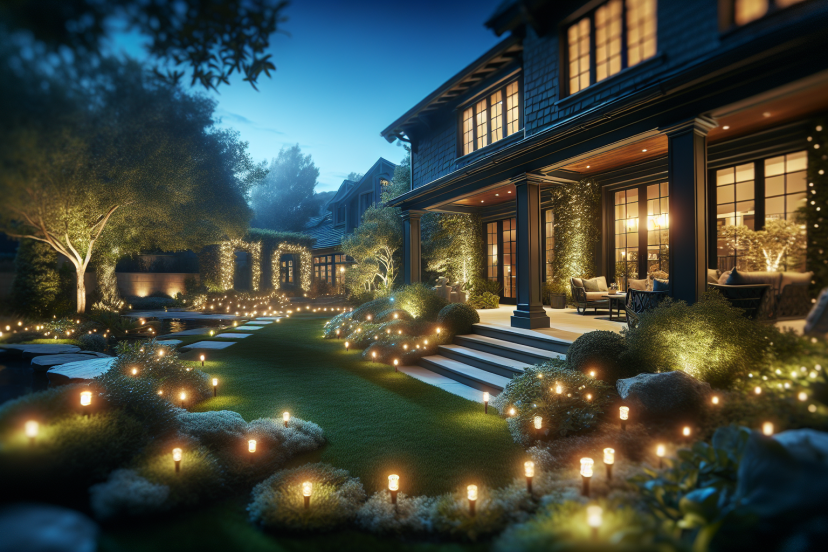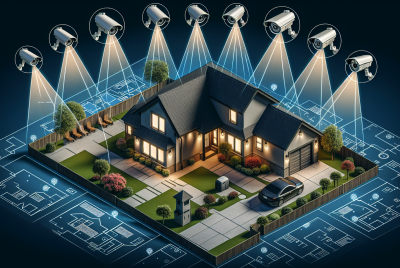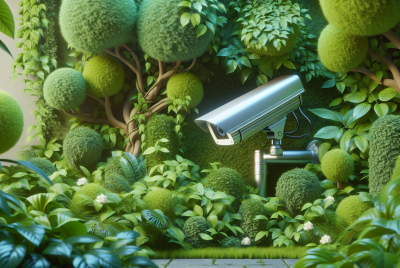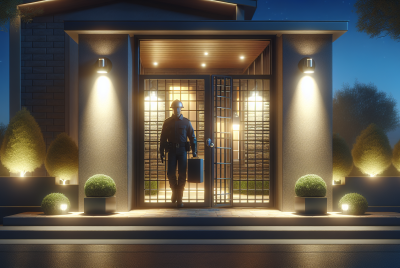Maximizing Energy Efficiency With Exterior LED Lighting
If you’re looking for ways to reduce your energy consumption and make your outdoor spaces more sustainable, exterior LED lighting is the solution you’ve been searching for. With their incredible energy efficiency and long lifespan, LED lights have revolutionized the lighting industry. In this article, we’ll explore how exterior LED lighting can help you save energy and lower your electricity bills while enhancing the beauty and functionality of your outdoor areas. From highlighting architectural features to illuminating pathways, we’ll show you how maximizing energy efficiency with exterior LED lighting is both environmentally friendly and aesthetically pleasing.
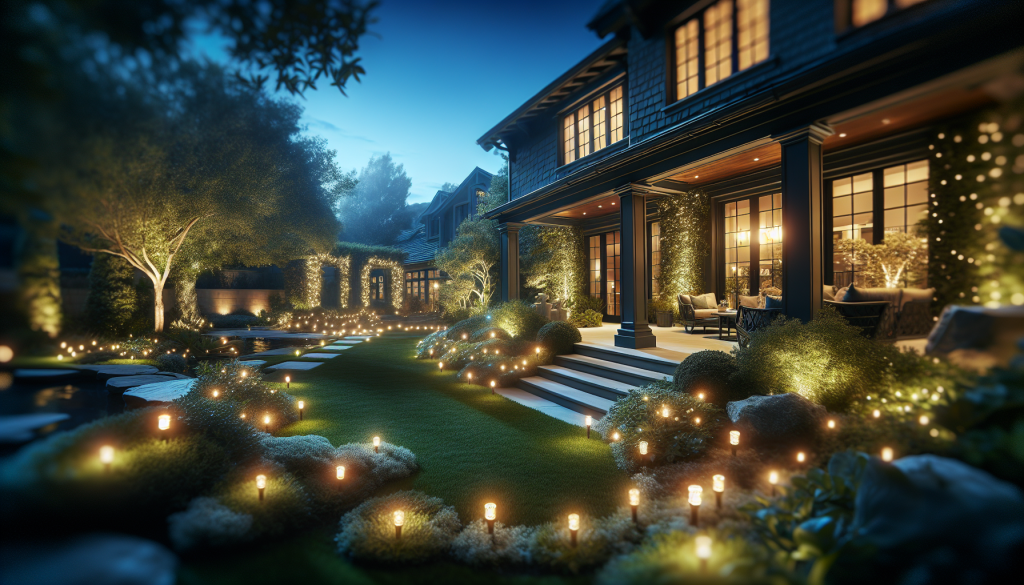
Benefits of Exterior LED Lighting
Long lifespan
One of the major benefits of using exterior LED lighting is its long lifespan. LED lights have an average lifespan of 50,000 to 100,000 hours, which is much longer than traditional lighting options such as incandescent bulbs or fluorescent lights. This not only minimizes the need for frequent replacements but also reduces maintenance costs.
Energy savings
Another advantage of exterior LED lighting is its energy efficiency. LED lights consume significantly less energy compared to traditional lighting sources, resulting in reduced electricity bills and lower carbon emissions. They convert most of the energy they use into light, rather than heat, making them an environmentally friendly choice.
Low maintenance
Exterior LED lighting requires minimal maintenance due to its durability and long lifespan. Unlike other lighting options, LED lights do not have fragile filaments or tubes that can easily break. This reduces the need for frequent replacements and lowers maintenance costs for businesses and homeowners alike.
Improved visibility
LED lights provide enhanced visibility for outdoor areas, improving safety and security. The bright and focused light output of LEDs ensures that objects and pathways are well-lit, reducing the risk of accidents and promoting a sense of security for residents, visitors, and employees. Exterior LED lighting can be strategically placed to illuminate parking lots, walkways, entrances, and other areas that require increased visibility.
Factors to Consider for Energy Efficiency
Lighting fixtures
Choosing the right lighting fixtures is crucial for maximizing energy efficiency. LED fixtures come in various shapes and sizes, catering to different lighting requirements. It is important to select fixtures that are specifically designed for outdoor use to ensure durability and resistance to harsh weather conditions. Additionally, considering fixtures with built-in heat sinks can help dissipate excess heat, leading to increased efficiency and longevity.
Lighting layout
Proper lighting layout plays a significant role in energy efficiency. By strategically placing fixtures, you can avoid over-illumination and unnecessary energy consumption. Analyzing the specific needs of the outdoor space, such as pathways, parking areas, or landscape features, can help determine the optimal placement of fixtures to achieve effective lighting while minimizing energy waste.
Color temperature
The color temperature of outdoor LED lighting is an important consideration. Color temperature refers to the visual appearance of light, ranging from warm to cool. For exterior lighting, a color temperature between 4000K and 5000K is generally recommended. This provides a bright, white light that enhances visibility without being overly harsh or intrusive.
Lighting controls
Implementing lighting controls further enhances energy efficiency. Lighting control systems such as timers, motion sensors, and dimmers help regulate the usage of exterior LED lighting. Timers can be programmed to automatically turn the lights on and off based on specific time schedules, while motion sensors detect movement and activate the lights only when necessary. Dimmers allow for adjustable lighting levels, reducing energy consumption during periods of low activity.
Importance of Proper Placement
Directional lighting
Properly directing the light emitted from exterior LED fixtures is essential for efficient lighting. By aiming the light towards the intended area, such as walkways or signage, unnecessary light spillage can be minimized, reducing energy waste. Directional lighting can also contribute to the overall aesthetic appeal by emphasizing architectural features or landscaping elements.
Avoiding light pollution
Light pollution is a significant concern when it comes to exterior lighting. Excessive and poorly directed light can contribute to skyglow and obstruct the view of stars. It can also disrupt natural ecosystems, affecting wildlife behavior and migration patterns. By carefully designing the placement and direction of exterior LED lighting, light pollution can be minimized, ensuring the preservation of natural beauty and ecosystems.
Optimal positioning for safety and security
properly positioning exterior LED lighting is crucial for ensuring safety and security. Well-placed lights can deter potential intruders and provide clear visibility of outdoor areas, reducing the risk of accidents and criminal activities. Assessing areas that require increased security, such as entry points or parking lots, and strategically placing fixtures can enhance safety and peace of mind for residents, customers, and employees.
Choosing the Right Fixtures
LED wattage and lumens
When selecting LED fixtures for exterior lighting, considering the wattage and lumens is important. Wattage indicates the power consumption of the light, while lumens measure the brightness output. Opting for fixtures with lower wattage and higher lumens ensures energy efficiency without compromising on required illumination levels. It is essential to assess the specific lighting needs of the outdoor space to determine the appropriate wattage and lumens for each area.
Quality and durability
The quality and durability of LED fixtures are crucial for long-term performance and energy efficiency. High-quality fixtures are designed to withstand the elements, such as rain, wind, and extreme temperatures, ensuring reliable operation over an extended period. Investing in durable fixtures eliminates the need for frequent replacements, reducing maintenance costs and contributing to long-term energy savings.
Waterproof and weatherproof ratings
Given their outdoor application, LED fixtures should have appropriate waterproof and weatherproof ratings. Look for fixtures that are IP65 or higher, indicating their resistance to dust and protection against water jets from any direction. Waterproof and weatherproof fixtures will withstand rain, snow, and humidity, ensuring the longevity and reliability of the lighting system in all weather conditions.
Smart lighting options
Consider incorporating smart lighting options into your exterior LED lighting system. Smart lighting allows for remote access and control, enabling adjustments to lighting levels, schedules, and operations from anywhere using a smartphone or computer. This not only enhances convenience but also contributes to energy efficiency by allowing precise control over lighting usage. Smart lighting options can be integrated with other systems such as security or motion sensors, maximizing the overall efficiency of the lighting system.
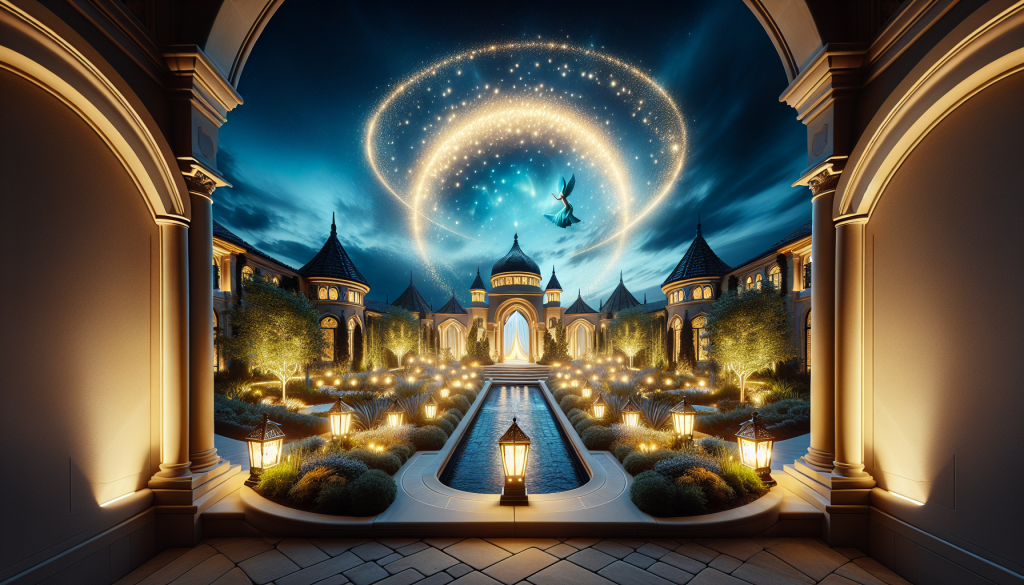
Utilizing Smart Lighting Controls
Motion sensors
Motion sensors play a vital role in energy-efficient exterior lighting. By detecting movement, they can activate the lights only when needed, saving energy and reducing light pollution. Motion sensors are particularly useful for areas with intermittent or sporadic activity, such as parking lots or pathways. Incorporating motion sensors into your exterior LED lighting system ensures lighting is utilized only when necessary, maximizing energy savings.
Timers and schedules
Implementing timers and schedules for your exterior LED lighting system allows for automated control. Timers can be set to turn the lights on and off at specific times, aligning with the operating hours of the space. This eliminates the need for manual control and ensures that lights are not left on unnecessarily, reducing energy waste. Schedules can be customized based on usage patterns, ensuring that lighting is available when and where it is required.
Dimmers and adjustable settings
Dimmers and adjustable settings enhance energy efficiency by allowing flexibility in lighting levels. Exterior LED lighting can be adjusted to match the desired brightness, depending on the time of day or specific requirements. Dimming the lights during periods of low activity or utilizing lower brightness levels in certain areas can significantly reduce energy consumption while still providing adequate illumination. Incorporating dimmers and adjustable settings into the lighting controls offers greater customization and energy savings.
Remote monitoring and control
Smart lighting controls also allow for remote monitoring and control of the exterior LED lighting system. Through a centralized system or mobile application, users can monitor the energy usage, status, and performance of the lights. In case of any issues or anomalies, immediate action can be taken, minimizing downtime and ensuring optimal energy efficiency. Remote control capabilities provide convenience and enable proactive management of the lighting system, enhancing its overall efficiency.
Considering Outdoor Environment Factors
Temperature variations
Outdoor LED lighting should be able to withstand temperature variations without compromising performance. Extreme heat or cold can affect the efficiency and lifespan of the fixtures. Look for LED lighting options that have a wide operating temperature range to ensure consistent and reliable operation under varying climate conditions.
Humidity and moisture
Moisture and humidity can potentially damage outdoor lighting fixtures. Ensure that the chosen LED fixtures have proper seals and gaskets to protect against moisture ingress. Investing in fixtures with adequate IP ratings for moisture resistance will prevent premature failure and maintain the performance and longevity of the lighting system.
Extreme weather conditions
Outdoor LED lighting should be capable of withstanding harsh weather conditions, such as heavy rain, snow, high winds, and even hail. It is essential to choose fixtures that are specifically designed for outdoor use and have appropriate durability ratings. By selecting weather-resistant lighting options, you can ensure that the lighting system remains operational and efficient even under extreme weather events.
Insect and pest resistance
Outdoor lighting fixtures are prone to attracting insects and pests, which can compromise the system’s efficiency and longevity. Opt for fixtures with insect-resistant designs, such as sealed enclosures or bug shields. Preventing insects and pests from entering the fixtures reduces the need for frequent cleaning and maintenance, ensuring uninterrupted performance and energy efficiency.
Maintenance and Upgrades
Regular cleaning and inspection
Regular cleaning and inspection of exterior LED lighting fixtures are necessary to maintain optimal performance and energy efficiency. Dust, dirt, and debris can accumulate on the fixtures, reducing the amount of light output and potentially overheating the components. Regularly cleaning the fixtures helps ensure maximum light output and prevents energy waste. Additionally, periodic inspection allows for early identification and resolution of any issues or damage to the lighting system.
Replacing outdated fixtures
As technology advances, newer and more energy-efficient LED fixtures become available. Periodically assessing the fixtures and replacing outdated ones with more efficient models can enhance energy savings. Upgrading to fixtures with higher lumens per watt efficacy and advanced features ensures that you are maximizing energy efficiency and taking advantage of the latest technology advancements.
Upgrading to more efficient models
Upgrading to more efficient LED models not only improves energy efficiency but also provides better lighting quality. Newer LED fixtures often have higher efficacy, meaning they produce more light output using less energy. By upgrading to more efficient models, you can achieve the same or better lighting levels while consuming less power, resulting in significant energy and cost savings.
Checking for energy-saving certifications
When selecting LED fixtures for exterior lighting, look for energy-saving certifications such as ENERGY STAR or DesignLights Consortium (DLC) listings. These certifications indicate that the fixtures meet strict energy efficiency standards and have undergone rigorous testing. Choosing fixtures with such certifications ensures that you are investing in high-quality, energy-saving products that will deliver the desired performance and efficiency.
Effect of Light Pollution
Negative impact on wildlife
Excessive and poorly directed exterior lighting can have a negative impact on wildlife. Bright lights can disorient birds, bats, and other nocturnal creatures, interfering with their natural behavior patterns and migration routes. By minimizing light pollution through proper placement and shielding of exterior LED lighting, we can help protect and preserve the natural habitats and biodiversity around us.
Disruption of natural ecosystems
Light pollution can disrupt natural ecosystems, affecting the balance and functioning of ecosystems. It can interfere with plant growth and development, alter predator-prey relationships, and disrupt the natural behavior of animals. By being mindful of the environmental impact of outdoor lighting and adopting measures to minimize light pollution, we can help protect and sustain healthy ecosystems.
Ways to minimize light pollution
To minimize light pollution, it is important to consider the following measures:
-
Use shielded fixtures: Install fixtures that direct light downwards and minimize upward light spillage. This reduces the amount of light that escapes into the sky and contributes to excessive lighting.
-
Control brightness and intensity: Use dimmers or adjustable settings to reduce brightness levels during periods of low activity or when a lower intensity of light is sufficient.
-
Select warm-colored lights: Warm-colored LEDs emit less blue light, which tends to contribute more to light pollution. Choosing warm-colored lights can help mitigate the negative effects of light pollution.
-
Turn off lights when not needed: Implement timers or motion sensors to automatically turn off lights when there is no activity in the area. This prevents unnecessary energy consumption and reduces light pollution.
Importance of shielding and directed lighting
Proper shielding and directed lighting are crucial to minimizing light pollution. Shielding fixtures prevents light from escaping upwards or into areas where it is not needed, such as the night sky or neighboring properties. Directed lighting ensures that light is focused on the intended area, allowing for sufficient illumination while minimizing unnecessary light spillage. By prioritizing shielding and directed lighting, we can help preserve the natural darkness of the night sky and prevent light pollution.
Cost Considerations
Initial investment vs long-term savings
While the initial investment in exterior LED lighting may be higher compared to traditional lighting options, the long-term savings outweigh the initial costs. LED lights have a longer lifespan, reducing the frequency of replacements and associated maintenance expenses. Additionally, the energy savings achieved through LED efficiency lead to lower electricity bills, resulting in significant long-term cost savings.
Return on investment (ROI)
Exterior LED lighting offers a favorable return on investment (ROI). The energy savings and reduced maintenance costs contribute to a quick payback period. By calculating the savings in energy consumption and maintenance expense reduction, businesses and homeowners can estimate the ROI and make informed decisions about the investment in LED lighting.
Government incentives and rebates
Many governments, utilities, and organizations offer incentives and rebates to encourage the adoption of energy-efficient lighting solutions, including LED lighting. These incentives can significantly offset the initial costs of installing exterior LED lighting. It is worth researching and exploring the available incentives and rebate programs in your area to maximize cost savings and make the transition to LED lighting more affordable.
Life cycle cost analysis
Performing a life cycle cost analysis can help determine the true cost-effectiveness of exterior LED lighting. This analysis involves evaluating the total cost of ownership over the life span of the lighting system. It includes factors such as initial costs, energy consumption, maintenance expenses, and replacement costs. By considering the entire life cycle cost, businesses and homeowners can make informed decisions and fully understand the financial benefits of investing in exterior LED lighting.
Case Studies and Success Stories
Real-world examples of energy-efficient exterior lighting
Several real-world examples demonstrate the success and benefits of energy-efficient exterior LED lighting. For instance, a parking lot in a commercial complex transitioned to LED lighting, resulting in a 50% reduction in energy consumption and significant cost savings. Another example is a municipality that upgraded its street lighting to LED, improving visibility, enhancing safety, and achieving substantial energy savings.
Impact on energy consumption and cost savings
The impact of energy-efficient exterior LED lighting on energy consumption and cost savings is significant. Case studies reveal reductions in energy consumption ranging from 40% to 70%, leading to substantial cost savings for businesses and municipalities. These savings can be redirected towards other sustainability initiatives or investments, contributing to environmental and financial benefits.
Positive feedback and user experiences
Users of energy-efficient exterior LED lighting have consistently provided positive feedback. Improved visibility, enhanced safety, and reduced maintenance requirements are common themes among user experiences. Customers appreciate the longer lifespan of LED lights, as it minimizes the inconvenience and cost associated with frequent replacements. Overall, the transition to LED lighting has been well-received and highly valued by users.
Lessons learned for future installations
The success stories and case studies of energy-efficient exterior LED lighting provide valuable lessons for future installations. Proper planning, thorough analysis of lighting requirements, and careful consideration of fixtures and controls lead to successful outcomes. Ensuring collaboration between stakeholders and engaging lighting professionals can result in well-designed lighting systems that maximize energy efficiency and user satisfaction. Continuous monitoring and maintenance are also crucial for long-term performance and sustainability.
In conclusion, maximizing energy efficiency with exterior LED lighting offers numerous benefits, including long lifespan, energy savings, low maintenance, and improved visibility. Factors such as lighting fixtures, lighting layout, color temperature, and lighting controls should be carefully considered for optimal energy efficiency. Proper placement, choosing the right fixtures, utilizing smart lighting controls, and considering outdoor environment factors are essential for achieving maximum efficiency and minimizing light pollution. Maintenance, upgrades, and cost considerations, including return on investment and available incentives, are important aspects to consider for long-term cost savings. Real-world case studies and success stories demonstrate the positive impact of energy-efficient exterior LED lighting, leading to energy savings, improved safety, and positive user experiences. Lessons learned from these examples provide insights and guidance for future installations, ensuring successful outcomes and long-term energy efficiency.

